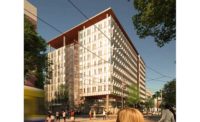Beauvoir, the project manager, says initial construction plans included a major bridge support landing in the middle of the busy Interstate 405 freeway. The contractor, Walsh/Shea Corridor Constructors, devised a way to eliminate that support and span across the freeway and "still make it an economic solution."
"That was a big win-win, avoiding having to deal with the freeway, Caltrans and the disruption to traffic, which would have been tremendous," he says.
Another project on the same freeway successfully using design-build is the $1-billion I-405 Sepulveda Pass Improvements, which adds a 10-mile HOV lane plus widens lanes from I-10 to U.S. 101 on one of the nation's busiest freeways. Currently about 95% complete, the project is being built by Omaha, Neb.-based Kiewit and designed by HNTB of Kansas City, Mo. Highway projects of this type would typically be managed by Caltrans, but Metro was brought in as the lead agency because of its extensive design-build expertise.
Project spokesperson Dave Sotero says that despite initial delays associated with utility relocation, the use of design-build shaved up to seven years off the project delivery. The new freeway lanes are expected to open this summer.
Design-build has become so popular at Metro that Dennis Mori says the entire agency is now using it on most—if not all—of its projects.
Mori is serving as project manager on the $2.86-billion Purple Line Extension Project, which has current funding for 3.9 miles of tunnels and three underground stations from Koreatown to Beverly Hills. The subway is an extension of the existing Purple Line that runs from Union Station to Koreatown.
Metro hopes to award the contract by this summer, give notice-to-proceed to a design-build contractor this fall, begin construction in early 2015 and deliver the project in 2023, Mori says.
Underground Challenges
Because it involves extensive tunneling through soil replete with methane gas, tar sands and ancient fossils, Mori sees the project as a great engineering opportunity for the future contractor.
"This is very exciting. We've had geologists, gas experts and paleontologists all involved in the project because it is so unusual in terms of construction," Mori says.
To help prepare contractors for the challenging underground environment, Metro has invested more than $6 million to dig a 75-ft-deep exploratory shaft at a key location known to be rich in fossils and will invite prospective design-builders to examine the findings. Mori says crews are encountering fossils, and Metro is working closely with the Natural History Museum of Los Angeles County to manage the excavation and recovery of the items.















Post a comment to this article
Report Abusive Comment